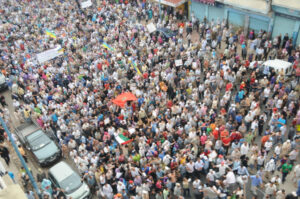As waves of democratization have happened around the globe, monarchies have largely disintegrated. However, in eight countries across MENA monarchies remain in power. As we investigate the persistence of monarchical authoritarianism in the region, we must investigate what factors challenge the continuation of monarchical rule and what assets this regime type has in confronting these challenges.
Citizenship, corruption, demonstration effects, and new media are common reasons subjects choose to revolt or mobilize against their monarchies. In monarchical rule, there is a significant difference between being a citizen and being a subject. A citizen usually considers themselves to have certain rights and responsibilities within a government, whereas a subject is more dependent on the whims of the monarchy. Those who seek rights in a government may feel impassioned to revolt against their monarchy.
Corruption is another reason why subjects may choose to mobilize. Pervasive patrimonialism upsets those whose opportunities have been taken away, especially in countries with a youth bulge and significant numbers of unemployment. When the government doesn’t have enough resources to support their population, the population becomes unhappy.
Another important challenge to monarchies is demonstration effects. This occurs when the population of one country sees learning across borders and realizes that they can adopt similar behaviors, whether that be protests or something else.
Finally, new media, such as Facebook, and mass media, such as satellite television, are used as a tool for the amplification of issues and the mobilization of people. These factors are challenges to the continuation of monarchical rule in MENA.
Monarchies respond to these factors in various ways, depending on the resources they have available. Violent repression can be used, as seen in Bahrain’s suppression of protestors during the 2011 Arab Uprisings, but it is unpopular due to its cost and inefficiency. Instead, to survive, monarchies usually capitalize on splits within their populations and adopt policies of political liberalization.
Geographic and social splits within a population can drive a wedge between people, preventing their mobilization. An example of this is seen in Bahrain, where the ruling government is Sunni Muslim and the population is largely Shiite. During the 2011 Arab Uprisings, the government framed protests as purely sectarian, delegitimizing them and making Sunnis less likely to become involved. Properly manipulating splits in a population such as this one isolates a population from each other, preventing mass mobilization.

Stepnout, Protesters camped out infront of the Pearl Roundabout on March 4th 2011, days before it was destroyed on March 18th 2011.
Additionally, political liberalization is a common survival strategy for authoritarian monarchies. This is commonly seen in monarchies’ tolerance of social pluralism and temporary democratic bargains. An example of this is in Morrocco, where in response to the 2011 Arab Uprisings the Morrocan king created a commission to explore constitutional reform. This commission allowed the monarchy to “hear” everyone’s opinions and “compromise” with subjects while acting as a play for time until everyone cooled off. In reality, the commission didn’t achieve much besides keeping the king in power. This is also known as tanfis, or allowing a small amount of opposition to depressurize the population.

Magharebia, Young people turn out en masse to lobby for a role in the nation’s future
It is important that as new challenges arise, we continue to study the responses of monarchs in MENA, observing how their actions allow their monarchies to survive or fail. In doing so we gain a greater understanding of political forces in the region and the dynamics of different regime types.
Works Cited:
Russell, Lucas. 2004. “Monarchical Authoritarianism: Survival And Political Liberalization In A Middle Eastern Regime Type” International Journal of Middle East Studies 36, 1: 103-119
Webb, Ed. 2023. “The Monarchies’ Responses to the Arab Uprisings of 2011”, Class lecture, Authoritarianism and Change in the Middle East and North Africa, Dickinson College, Carlisle, Pennsylvania, October 26, 2023.